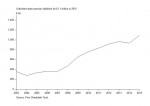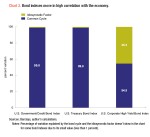Economy
Home improvement spending is growing at a healthy pace.
Residential investment has boosted U.S. economic growth in most quarters since 2011 (Chart 1 bars). Most residential investment is new site construction, or building new single-family or multifamily homes. In the past, new site construction accounted for 75 percent to 80 percent of residential investment. This activity can be tracked in monthly data on residential construction. Data on new and existing home sales also help gauge overall conditions in the housing market.
The remaining 20 to 25 percent of residential investment has been spending on improvements. But during the housing boom that preceded the Great Recession, spending on remodeling fell to less than 20 percent as new site construction surged. That reversed during the Great Recession, when new construction plunged, pushing home improvement’s share of total residential investment to 40 percent. Following the recession, new construction began to recover, and home improvement’s share drifted down to just over 30 percent, below the peak but still well above the average from before the housing boom.
Home improvement investment is closely related to spending at retailers of building materials and garden equipment and supplies (Chart 2). Both measures hit their best growth rates for a decade in the years before the Great Recession. During the recession, both growth rates turned negative. Since the recession, home improvements have exceeded 10 percent year-over-year growth on four occasions. In turn, retail spending for remodeling equipment and supplies has exceeded 5 percent growth for most of the past three years.
Low interest rates and a strong labor market should support new home construction, yet the rebound in residential investment overall remains moderate. Many factors are likely contributing to this, but one bright spot in residential investment is home improvements.
Economic Outlook
Our Business-Cycle Conditions Leaders index points to moderate economic growth in the months ahead. The Leaders remained at 42 in August, unchanged from July (Chart 3). August marks the seventh consecutive month that the Leaders have bounced around in the 38-to-50 range. Normally, readings below 50 begin to raise warnings about an increased risk of recession. However, we believe the results over the past seven months are consistent with overall slow-growth.
Among the indicators we see a pattern that is consistent with our qualitative assessment of the economy. Initial claims for unemployment insurance are near record lows (a positive result in our BCC model), while the average workweek in manufacturing has moved higher, providing support for the upward trend in real retail spending. Offsetting this are deterioration in consumer expectations and real new orders for consumer goods.
Positive results are coming from two out of three of our financial indicators. Trends in real stock prices and the yield curve have been favorable, while debit balances in margin accounts have been negative. Weakness in manufacturing and capital investment-related indicators balance out the positive tilts among consumer-related and financial-related indicators. These data confirm that the consumer sector is likely to remain the engine of growth offsetting weakness in capital investment.
Among our other indicators, the Coinciders index moved up to 83 in August from 75 in July, while the Laggers index dropped to 75 from 100 in July.
Click for interactive Indicators at a Glance (on mobile device turn to landscape)
Next/Previous Section:
1. Overview
2. Economy
3. Inflation
4. Policy
5. Investing
6. Pulling It All Together/Appendix



